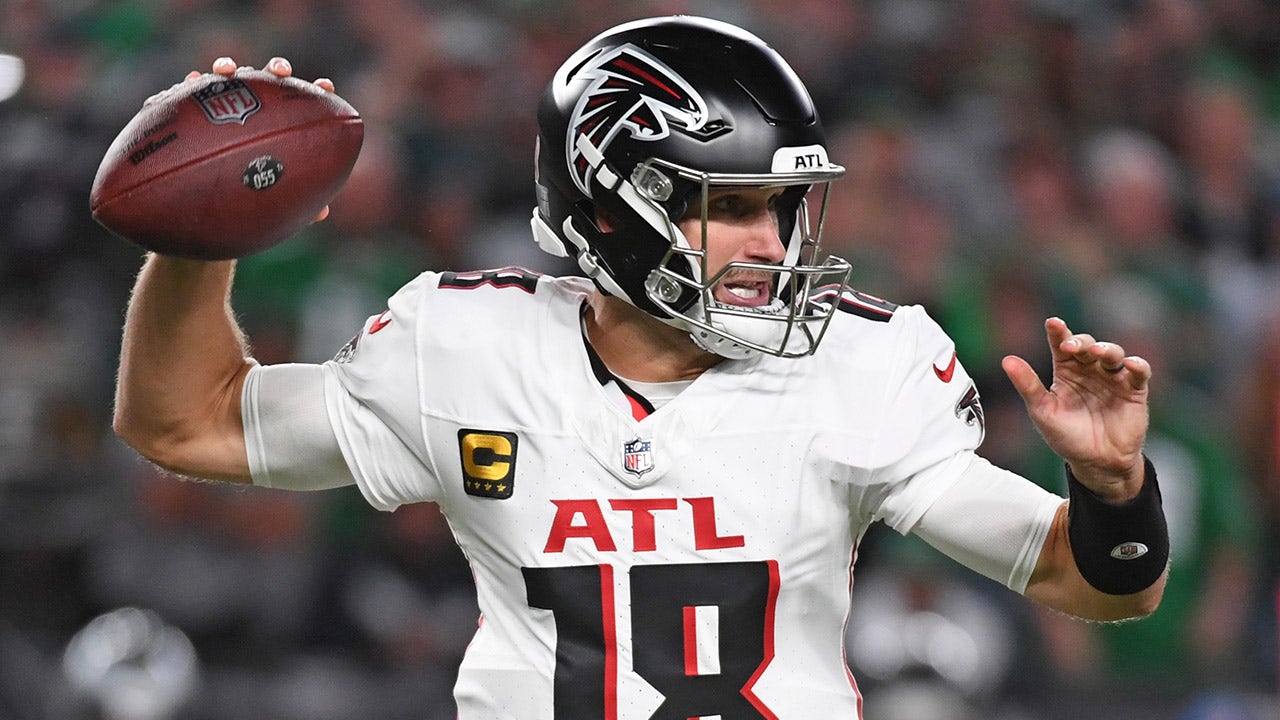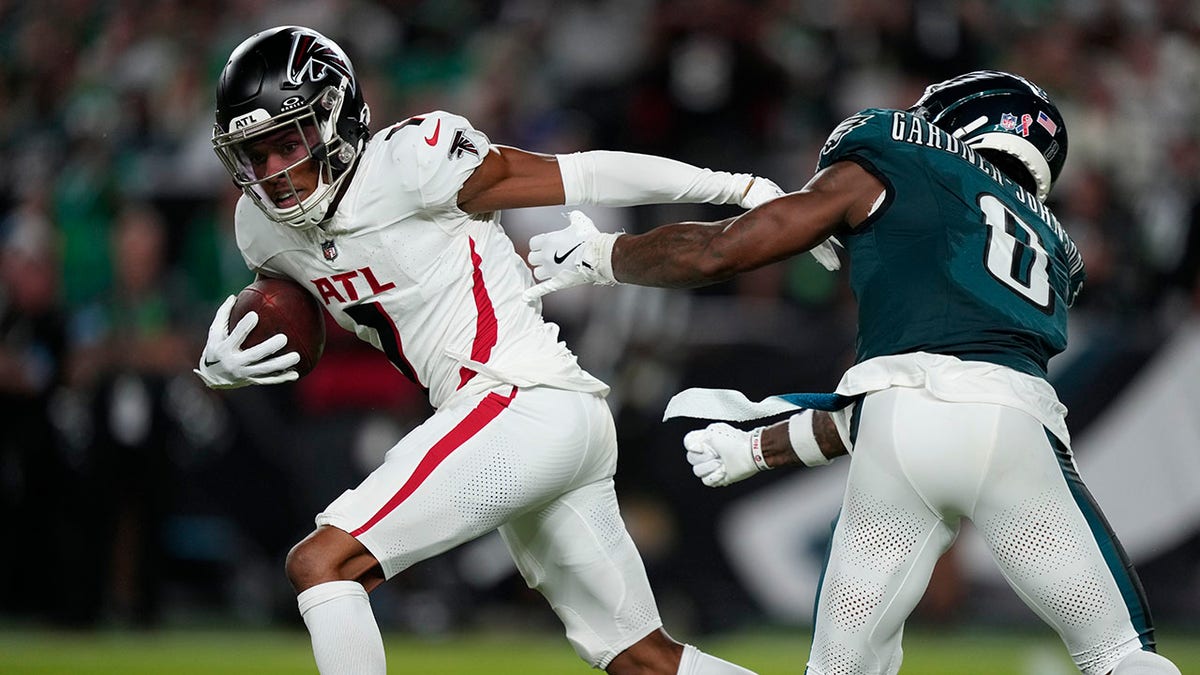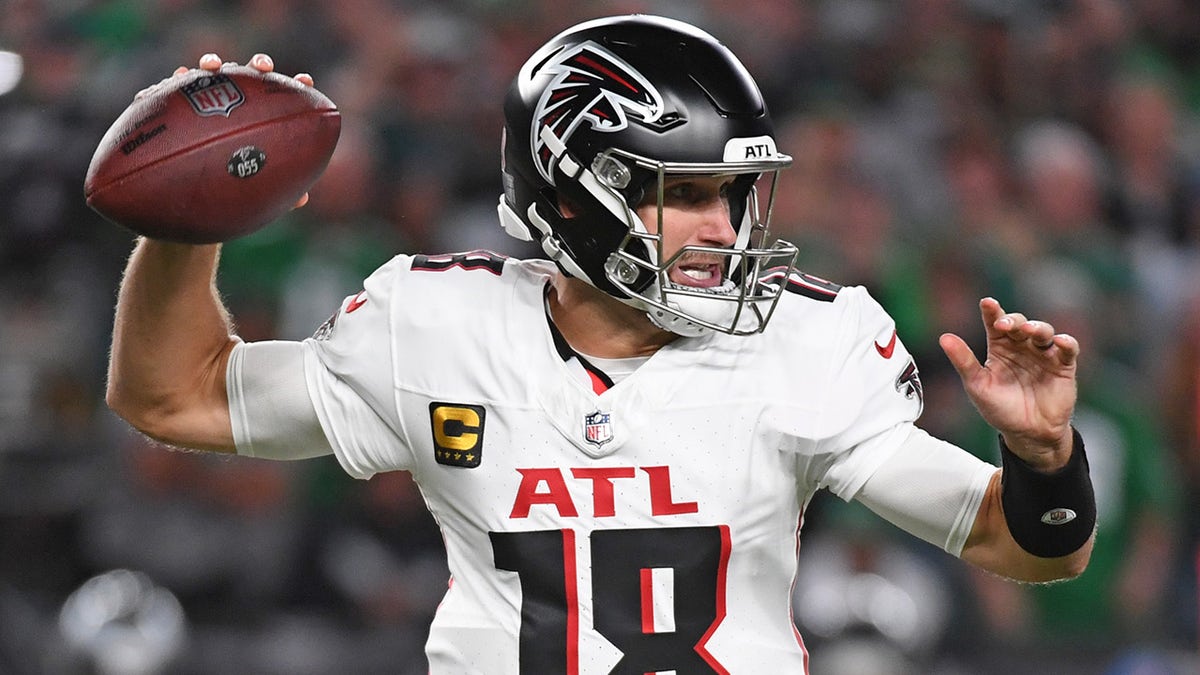Sports
Falcons' Kirk Cousins leads miraculous last-minute drive to shock Eagles on the road

A stale offensive game turned into an absolute shocker on “Monday Night Football,” as the Atlanta Falcons took down the Philadelphia Eagles, 22-21, thanks to a brilliant Kirk Cousins last-minute drive.
The key play of the game was a third-and-short situation in the Falcons’ red zone, where quarterback Jalen Hurts did play action instead of running the ball to kill more clock, and he was looking for Saquon Barkley.
Barkley, who had a tremendous Eagles debut with three touchdowns, appeared destined for a first down that would’ve iced the game – had he caught the ball. With the drop, the clock stopped, bringing on kicker Jake Elliott for the field goal to make it an 18-15 game.
Philadelphia Eagles running back Saquon Barkley (26) runs with the ball against the Atlanta Falcons during the first quarter at Lincoln Financial Field. (Bill Streicher-Imagn Images)
So, with 1:39 left on the clock, Cousins and the Falcons’ offense, with no timeouts, had a chance to drive down the field and score a touchdown with the extra point needing to be hit for the victory.
Well, Cousins got to work, finding his tight end Kyle Pitts for 11 yards and then two catches by Darnell Mooney for a total 47 yards to get in Philadelphia’s red zone.
Then, on third-and-5 from the Philadelphia 7-yard line, Drake London ran a perfect out route that Cousins found him on in the end zone and the Lincoln Financial Field crowd went dead silent.
JALEN HURTS SHARES HEARTFELT WORDS WITH EX-EAGLES TEAMMATE JASON KELCE: ‘I LOVE YOU’
A small wrinkle in the Falcons’ potential game-winning extra point came when London was called for excessive celebration, moving the 33-yard attempt back to 48 yards. But Younghoe Koo buried it down the middle.
The Eagles, with all of their timeouts, still had a chance to get into field goal range for Elliott to save the night, but Hurts, who had a great game prior, threw an interception to safety Jessie Bates III to wipe out that possibility.
The Falcons and Eagles are now 1-1 after the stunner in Philly.

Atlanta Falcons wide receiver Darnell Mooney (1) runs past Philadelphia Eagles safety C.J. Gardner-Johnson (8) for a touchdown during the second half of an NFL football game Monday, Sept. 16, 2024, in Philadelphia. (AP Photo/Matt Slocum)
This game looked all but wrapped up when C.J. Gardner-Johnson stonewalled Bijan Robinson on fourth-and-1, turning the Falcons over on downs after the Eagles had just tush-pushed Hurts into the end zone to give themselves a three-point lead after Barkley had a two-point conversion.
But the saying it ain’t over until it’s over had another example added to its ranks thanks to some clutch passing by Cousins, who finished 20-of-29 through the air for 241 yards with two touchdowns.
Cousins had previously struggled in this game, and some were wondering if that repaired Achilles was bothering him as he was leaving passes short all night. But he let one fly in the third quarter to Mooney, who hauled in a 41-yard touchdown to give the Falcons a 15-10 lead. It was the longest play from scrimmage in a night where Mooney led Atlanta with 88 yards on just three receptions.
For the Eagles, DeVonta Smith, playing the role of top receiver with A.J. Brown sidelined due to a hamstring injury that likely has him out next week as well, had the game’s only touchdown before Mooney got in. He caught a seven-yard strike from Hurts in the second quarter.
Robinson was a key contributor for the Falcons on the ground, having a game-high 97 yards rushing on 14 carries. Barkley was two yards short of him on 22 carries, while Hurts had 85 yards on 13 tuck-and-runs.

Atlanta Falcons quarterback Kirk Cousins (18) throws a pass during the first quarter against the Philadelphia Eagles at Lincoln Financial Field. (Eric Hartline-Imagn Images)
Hurts was efficient before that game-ending interception, throwing for 183 yards on 23-of-30 passing.
Follow Fox News Digital’s sports coverage on X, and subscribe to the Fox News Sports Huddle newsletter.

Sports
Sam Darnold coming up short in loss to Rams has major implications for Vikings’ future at QB

GLENDALE, Ariz. — The look on Zygi Wilf’s face said it all. It was as if the Minnesota Vikings owner and chairman had just watched a horror movie with a gutting ending. He exited the locker room, stood for a few seconds and stared blankly at the crowd of people in front of him. His son, Jonathan, pointed him toward a long hallway. And off he went slowly into another offseason.
How did this end so abruptly? How did a 14-win Vikings team oscillate so quickly from being a potential No. 1 seed to losing in the wild-card round? Wilf’s mind turned with questions such as these.
None of them, though, were as confounding as this one: What happened to quarterback Sam Darnold?
Two weeks ago, Darnold’s Vikings teammates were dousing him with water bottles as part of a locker-room celebration following a win at U.S. Bank Stadium. Now, here they were Monday night at State Farm Stadium, zipping up their suitcases and heading for the buses after a brutal 27-9 loss to the underdog Los Angeles Rams.
GO DEEPER
Rams down Vikings 27-9 in wild-card game for date with Eagles: Takeaways
The dichotomy between the two scenes was as stark as it was disorienting. In the first snapshot, the 27-year-old Darnold seemed to have completed a career transformation and galvanized an organization in the process. In the second, it felt fair to wonder how much of Darnold’s impressive play this season was a mirage.
“I think it’s very important we all think about Sam’s body of work,” Vikings coach Kevin O’Connell said postgame. “It did not work out in the end, and I think Sam would be the first one to tell you (he could have played better).”
After a loss like this one, there are typically multiple culprits. The offensive line is another obvious one for Minnesota. The Rams sacked Darnold nine times, tying an NFL playoff record. Furthermore, 12 Rams defenders generated at least one pressure, according to Next Gen Stats, their most in a game since Week 6 in 2021.
Hoecht throws up the “LA” after the Rams latest sack
📺: #MINvsLAR on ESPN/ABC
📱: Stream on @NFLPlus and ESPN+ pic.twitter.com/iWM1Pofp0U— NFL (@NFL) January 14, 2025
Allocating cap space and draft capital to interior offensive linemen will be a priority this offseason. O’Connell suggested as much Monday night.
Still, that concern pales in comparison to the importance of what happens at quarterback — and what that means for everything else — which is why Darnold’s drop-off over the last two weeks is so jarring.
After playing well enough over the first 16 games to lead the Vikings to a 14-2 record and legitimately be in the conversation for NFL MVP, Darnold struggled mightily in the regular-season finale, a 31-9 loss in Detroit. Against the Lions, he completed just 18 of 41 passes for 166 yards, posting his third-worst passer rating (55.5) and his highest bad-throw percentage of the season (34.2).

GO DEEPER
Did Vikings’ struggles against Lions show a blueprint for how to slow down Sam Darnold?
Those troubles continued against the Rams. His numbers — 25-for-40 passing for 245 yards, a touchdown and an interception — belied Darnold’s level of comfort. He misplaced multiple throws. Darnold, who so often this season had been pinpoint accurate, threw behind his receivers. He spun out of the pocket but failed to get the ball off. His eyes often scanned from right to left too quickly. His feet swiveled back and forth constantly. He tried to evade pass rushers, who engulfed him almost every time.
Darnold’s system malfunctioned in almost every regard. When it wasn’t his vision, it was his footwork. When it wasn’t his vision or his footwork, it was his arm.
“Left too many throws out there that I would usually make,” he said afterward.
Had he said that earlier in his career in New York or Carolina, some might have laughed. But this season, while entrusted in O’Connell’s scheme and developmental process, he proved over a meaningful sample size that he could progress in rhythm, deliver the football accurately and withstand pressure.
Darnold had also displayed resilience, navigating a difficult midseason stretch against the Colts and Jaguars during which he threw five interceptions. The way he responded to those tough film sessions, throwing 18 touchdowns and two interceptions in the ensuing seven games, showed just what he was capable of.
In late December, The Athletic’s Dianna Russini reported, “After conversations with a team source, one thing is clear: The Vikings want Darnold back in Minnesota for 2025.” Separately, another Vikings staffer texted, “I hope we can keep him.” Darnold’s MVP odds climbed. Against the Packers in the team’s final home game of the season, he completed 33 of 43 passes for 377 yards, three touchdowns and an interception and was soaked by teammates afterward in the locker room.
The Sam Darnold experience continues. pic.twitter.com/k5db9DYdtp
— Alec Lewis (@alec_lewis) December 30, 2024
This 2024 Vikings season, billed as a transition year toward a more flexible future around rookie quarterback J.J. McCarthy, had exceeded even the rosiest expectations.
“Outside of these walls, nobody really believed in him,” running back Aaron Jones said of Darnold at the time. “Nobody gave him a chance. But he’s proving everybody wrong.”
That was the crescendo, a byproduct of an infrastructure optimized in Darnold’s image. At the time, the Vikings staff reiterated the role that rhythm and timing played in Darnold’s success and how important it was for his feet and eyes to sync.
Buried in the jargon was an important reality: Darnold trusted the play calls and reads so much that it was more about sticking to a specific timing than observing the field and making decisions based on what he saw. The best way to sum up his struggles in Detroit and Arizona was an interruption in timing. Both the Lions and Rams affected Darnold’s ability to climb up in the pocket, and both teams mixed in countless stunts and exotic pressures to keep Darnold from being comfortable, assessing the picture downfield and throwing.
There were numerous examples from Monday night. Early in the second quarter, Darnold dropped back and eyed the right sideline. Rams defensive lineman Braden Fiske pushed Vikings left guard Blake Brandel toward Darnold, who side-stepped and kept his eyes on receiver Jordan Addison, while receiver Jalen Nailor was open crossing the field. Darnold hurled a pass in Addison’s direction. But the ball was late and behind Addison, and it was intercepted by Rams cornerback Cobie Durant.
Later in the quarter, the Rams blitzed safety Quentin Lake from depth. He squeaked past right guard Dalton Risner, forcing Darnold to step up and move his vision from right to left. Uncertain with what he was seeing, he looked back to his right. But before he could release the ball, another blitzer, Rams cornerback Ahkello Witherspoon, speared him in the back. Darnold fumbled, and Rams edge rusher Jared Verse recovered and rumbled 57 yards for a touchdown, extending Los Angeles’ lead.
JARED VERSE SCOOP AND SCORE!
📺: #MINvsLAR on ESPN/ABC
📱: Stream on @NFLPlus and ESPN+ pic.twitter.com/bXLHmOUaQW— NFL (@NFL) January 14, 2025
“There are some examples where, when you go back and watch the tape in an air-conditioned room tomorrow, it’s going to feel like, ‘Man, why didn’t I just do this or that?’” O’Connell said. “But it’s hard in the moment. It’s hard with how fast things happen out there.”
Good quarterbacks have the arm and the athleticism, especially in the modern NFL, but the mind is what separates the top-tier QBs. Matthew Stafford’s operating capacity on the other side of the field validated this, and Monday night substantiated a popular opinion regarding the Vikings’ future: Franchise-tagging or extending Darnold, who is set to become a free agent, does not make sense with the team’s needs elsewhere, especially on the interior of the offensive line.
Moving on from Darnold would, of course, raise questions. How ready is McCarthy? Which veteran option might the Vikings pair with McCarthy? And how would O’Connell feel about having to build up an entirely new quarterback option?
These are vastly different questions from the ones on Wilf’s mind as he wound his way through the bowels of the stadium Monday night. But they’ll soon be on his plate following a wildly successful season that ended in a disappointing flash, a roller-coaster ride for a quarterback who could not polish off the progress he’d built.
(Photo: Christian Petersen / Getty Images)
Sports
Daniil Medvedev smashes racket, camera during fiery outburst as he avoids Australian Open upset

Top-ranked tennis pro Daniil Medvedev destroyed a camera and his tennis racket as he faced what could have been a monumental upset in the Australian Open by a wild-card entry ranked 418th in the first round of the Grand Slam tournament on Tuesday.
Medvedev’s outburst came during the third set when he lost a 13-stroke back-and-forth with Thailand’s Kasidit Samrej to fall behind 40-15. With Medvedev up at the net, Samrej’s shot clipped the net to go beyond Medvedev’s reach in a direction he clearly could not have anticipated.
Daniil Medvedev reacts during his first-round match against Kasidit Samrej at the Australian Open in Melbourne, Tuesday, Jan. 14, 2025. (AP Photo/Ng Han Guan)
Then Medvedev, a three-time Australian Open finalist, unleashed his anger on the net, smashing his racket several times.
In the process, Medvedev destroyed his racket and a camera that was situated directly in his path of destruction.
Staff quickly rushed to replace the broken camera and clean up the debris on the court. Medvedev was given a code violation warning for racket abuse from the chair umpire.

Daniil Medvedev smashes a TV net camera with his racket as he has lost the third set against Kasidit Samrej in the men’s singles first-round match at Australian Open on Jan. 14, 2025. (Daniel Pockett/Getty Images)
COCO GAUFF DELIVERS 6-WORD MESSAGE FOR THOSE DEALING WITH LA WILDFIRES AFTER AUSTRALIAN OPEN WIN
Medvedev dropped the set to trail 2-1, and it looked as though the No. 5 ranked player would face elimination. But Medvedev quickly turned things around to win the following two sets 6-1, 6-2, and advanced to the second round.
“In the end of last year, this match, I probably would have lost it,” Medvedev said after the match. “New year, new energy.”

Daniil Medvedev’s outburst came during the third set when he lost a 13-stroke back-and-forth with Thailand’s Kasidit Samrej. (Daniel Pockett/Getty Images)
Medvedev is hoping to start out the 2025 season with a win in Melbourne. A three-time finalist, including in last year’s tournament, Medvedev has never won the Australian Open. His biggest challenger will be Novak Djokovic, who has won the most Australian Open titles than any other men’s player with 10.
The Associated Press contributed to this report.
Follow Fox News Digital’s sports coverage on X, and subscribe to the Fox News Sports Huddle newsletter.
Sports
Prep talk: CIF to waive transfer rules for high school athletes affected by fires

The California Interscholastic Federation is preparing this week to send out a form to the 10 section commissioners that would simplify transfer rules for families displaced because of the fires in Southern California, executive director Ron Nocetti said Tuesday.
The sections will make the transfer waiver form available to individual schools to complete, which would allow immediate athletic eligibility for individuals who lost their homes or were displaced.
“It’s a waiver from the normal transfer process, which could take quite a few days,” Nocetti said. “We allow administrators to make the judgment, ‘Yes, the student is here because of the fire, and yes, they can participate.’ We’re going to make it simple. This is the last thing we want families to worry about.”
Hundreds of homes have been damaged or destroyed in the Palisades fire and Eaton fire. The disruption will lead to tough family decisions about where to stay and where to move. Teenagers involved in athletics might have to switch schools.
This isn’t the first time the CIF has created provisions in its transfer rules for displaced families. When Hurricane Katrina caused extensive damage in Louisiana and Texas in 2005, the CIF created a similar waiver for families that moved to California.
Normal transfer rules require families to submit extensive information, such as utility bills, to establish residency. The new form will help expedite the paperwork.
This is a daily look at the positive happenings in high school sports. To submit any news, please email eric.sondheimer@latimes.com.
-

 Health1 week ago
Health1 week agoOzempic ‘microdosing’ is the new weight-loss trend: Should you try it?
-
/cdn.vox-cdn.com/uploads/chorus_asset/file/25822586/STK169_ZUCKERBERG_MAGA_STKS491_CVIRGINIA_A.jpg)
/cdn.vox-cdn.com/uploads/chorus_asset/file/25822586/STK169_ZUCKERBERG_MAGA_STKS491_CVIRGINIA_A.jpg) Technology6 days ago
Technology6 days agoMeta is highlighting a splintering global approach to online speech
-

 Science3 days ago
Science3 days agoMetro will offer free rides in L.A. through Sunday due to fires
-
/cdn.vox-cdn.com/uploads/chorus_asset/file/25821992/videoframe_720397.png)
/cdn.vox-cdn.com/uploads/chorus_asset/file/25821992/videoframe_720397.png) Technology7 days ago
Technology7 days agoLas Vegas police release ChatGPT logs from the suspect in the Cybertruck explosion
-

 Movie Reviews1 week ago
Movie Reviews1 week ago‘How to Make Millions Before Grandma Dies’ Review: Thai Oscar Entry Is a Disarmingly Sentimental Tear-Jerker
-

 Health1 week ago
Health1 week agoMichael J. Fox honored with Presidential Medal of Freedom for Parkinson’s research efforts
-

 Movie Reviews1 week ago
Movie Reviews1 week agoMovie Review: Millennials try to buy-in or opt-out of the “American Meltdown”
-

 News7 days ago
News7 days agoPhotos: Pacific Palisades Wildfire Engulfs Homes in an L.A. Neighborhood

















